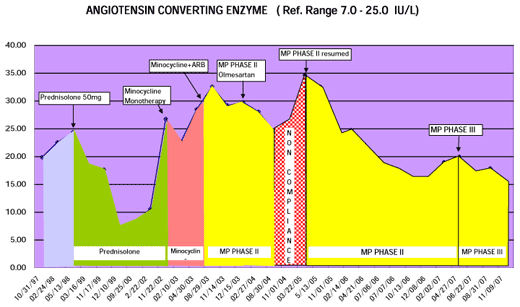
Table of Contents
Test: Angiotensin-Converting Enzyme (ACE)
Introduction
ACE test is described here.
ACE or angiotensin-converting enzyme “Elevated ACE indicates the same as the 1,25-DPrimary biologically active vitamin D hormone. Activates the vitamin D nuclear receptor. Produced by hydroxylation of 25-D. Also known as 1,25-dihydroxycholecalciferol, 1,25-hydroxyvitamin D and calcitirol. and therefore adds nothing to the interpretation, except an increased level of confidence. On the other hand, if ACE is normal (as so many are), the ACE gives a decreased level of confidence. Nevertheless, if cost is not a factor, I always like to see as much data as I can.” Dr. Trevor Marshall, PhD

Children
The authors of the study Serum angiotensin-converting enzyme in healthy and sarcoidotic children: comparison with the reference interval for adults measured the serum ACE of 187 healthy children between the ages six months and 18 years. Their report (at the link in blue text) includes detailed charts with discussion of the influence of age and gender on serum ACE.
ARB effect
Why has my ACE gone up since I started the MP?
Benicar blocks the RECEPTORS (on cells) that allow Angiotensin II to be used by the body. It actually induces INCREASED production of the hormone itself (angiotensin II) as your body tries to adjust for the lack of availability of the hormone at its receptors. You will find that serum ACE also rises while an Angiotensin Receptor Blockade is in place.
ACE (angiotensin converting enzyme) is an intermediate biochemical. It is an enzyme that converts Angiotensin I to Angiotensin II. It has no direct action in the inflammatory cycle other than to cause the release of quantities of Angiotensin II. That is probably why it is relatively insignificant in some patients; it depends on your Renin Angiotensin System activity level.
The more your ACE is initially elevated, the more ACE is being generated in your inflammationThe complex biological response of vascular tissues to harmful stimuli such as pathogens or damaged cells. It is a protective attempt by the organism to remove the injurious stimuli as well as initiate the healing process for the tissue., and the higher the ACE will go when the Angiotensin II receptors are blocked. We have had one report of ACE greater than 400.
The serum ACE usually rises to quite high levels when you have an Angiotensin Receptor Blockade in place (eg with Benicar).
This is because the inflamed tissue can't get any Angiotensin II binding at its receptors, so it puts out extra ACE to try and convert more Renin/A-1 into Angiotensin II (the Angiotensin-II level rises too). But even though all that Angiotensin II is manufactured, there are no receptors left for it to bind to, so it can do no harm.
Note that ACE is not the same as Angiotensin II. They are different chemicals and have vastly different functions. Our paper “New Treatments Emerge…” describes the biochemistry at “the Angiotensin Hypothesis”. Although put as a 'hypothesis' in that (old) paper, a Spanish group recently validated my etiology in-vitro and in rats. Trevor
Patient reports
Olmesartan Medoxomil 40mg q6hrs
It was seven years ago today I discovered https://www.sarcinfo.com and I now share wonderful news.
I had laboratory work done on 11/19/11 and my Angiotensin Converting Enzyme or ACE is now normal. It has been out of range since being diagnosed with sarcoidosis in December 2004.
I have no doubt in my mind or spirit that the MP works. It is a slow path, to be sure, but that's an advantage: you can't make too drastic of a mistake all at once (except stopping the Olmesartan Medoxomil IMO). And it also the constant attention to diet, keeping stress down, and moderate exercise (if you can).
Hooray for all of us.
Sherry

